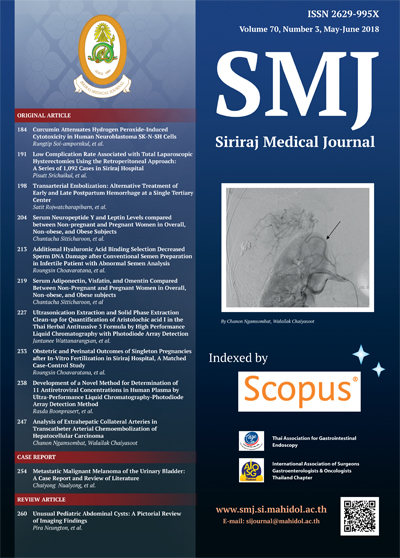Low Complication Rate Associated with Total Laparoscopic Hysterectomies Using the Retroperitoneal Approach: A Series of 1,092 Cases in Siriraj Hospital
Keywords:
Total laparoscopic hysterectomy; complication; associated factorAbstract
Objective: This study was performed to evaluate the incidence of and risk factors for major complications associated with the Siriraj total laparoscopic hysterectomy (SiTLH) technique.
Methods: In total, 1,092 patients who underwent SiTLH from January 2009 to December 2013 were enrolled in this retrospective study. The incidence of major complications such as death, vascular injury, visceral injury was
the main outcome. Comparison between the patients with and without complications was such as unintended laparoconversion, vascular injury, visceral injury performed to determine associated risk factors. Patient satisfaction was also evaluated.
Results: The incidence of major complications was 2.1%. There was a significantly increased risk of major complications among the patients with a uterine weight of ≥500 g (7.5% vs 1.8%, P =0.002), the patients with a uterine weight of ≥400 g and pelvic endometriosis (14.3% vs 1.9%, P =0.033), or experience of surgeon <15 years (2.9% vs 1.2%, P=0.049). In total, 1,031 (94.4%) of the patients were extremely satisfied with the results of surgery.
Conclusion: SiTLH technique is feasible and safe. However, the authors believe that good surgical skills and an understanding of the pelvic anatomy are essential to ensure good outcomes using our technique.
Downloads
Published
How to Cite
Issue
Section
License
Authors who publish with this journal agree to the following conditions:
Copyright Transfer
In submitting a manuscript, the authors acknowledge that the work will become the copyrighted property of Siriraj Medical Journal upon publication.
License
Articles are licensed under a Creative Commons Attribution-NonCommercial-NoDerivatives 4.0 International License (CC BY-NC-ND 4.0). This license allows for the sharing of the work for non-commercial purposes with proper attribution to the authors and the journal. However, it does not permit modifications or the creation of derivative works.
Sharing and Access
Authors are encouraged to share their article on their personal or institutional websites and through other non-commercial platforms. Doing so can increase readership and citations.











